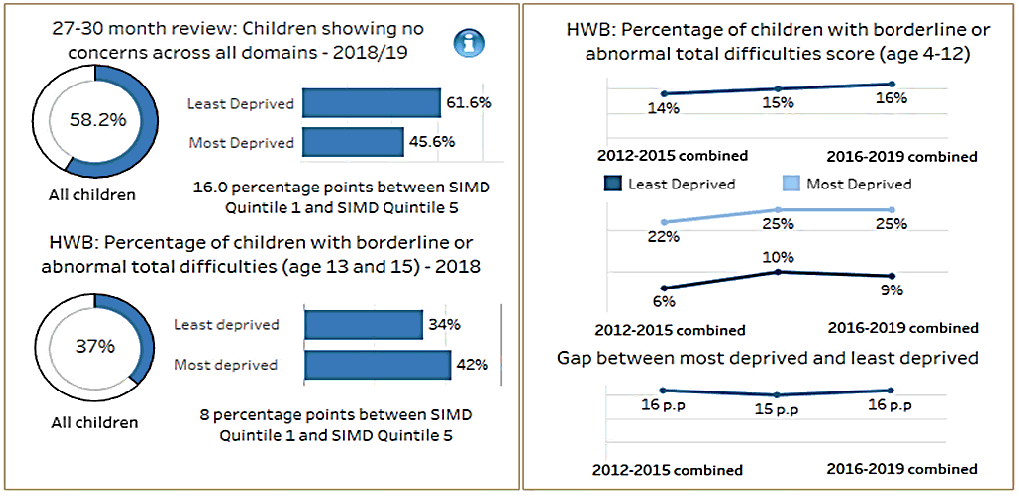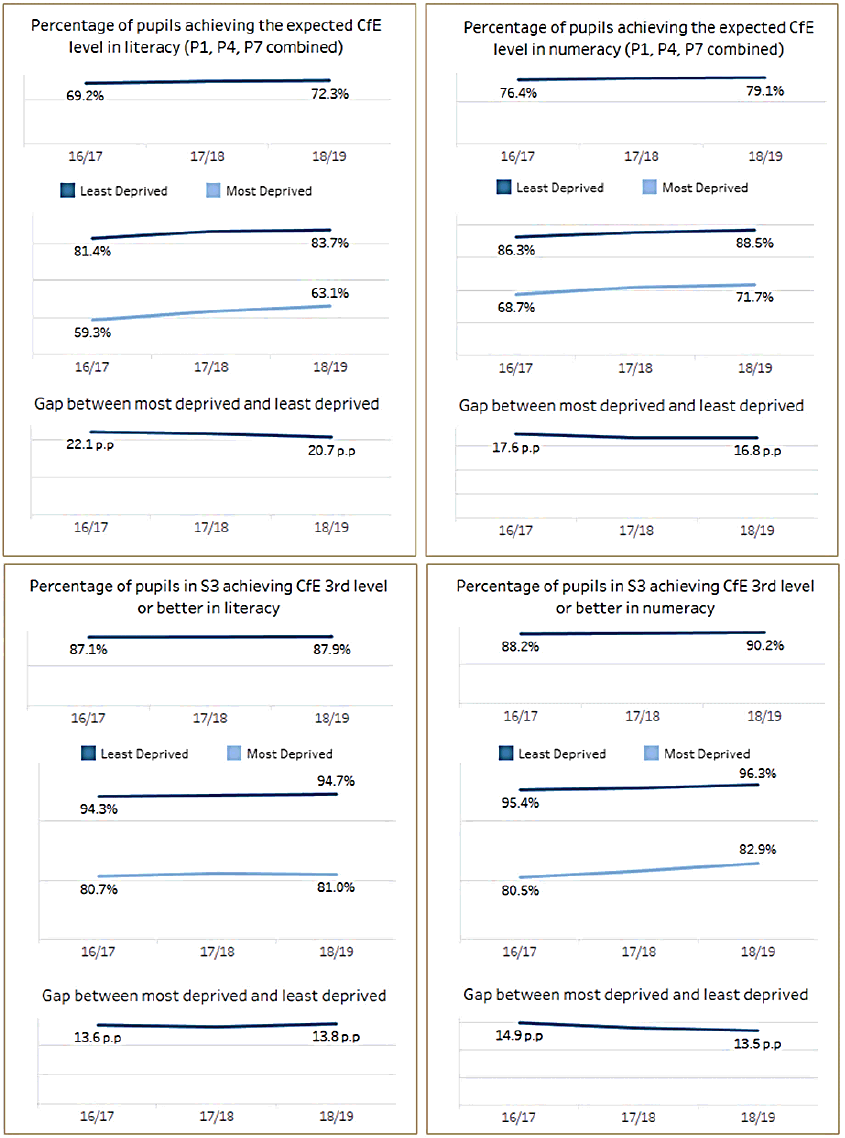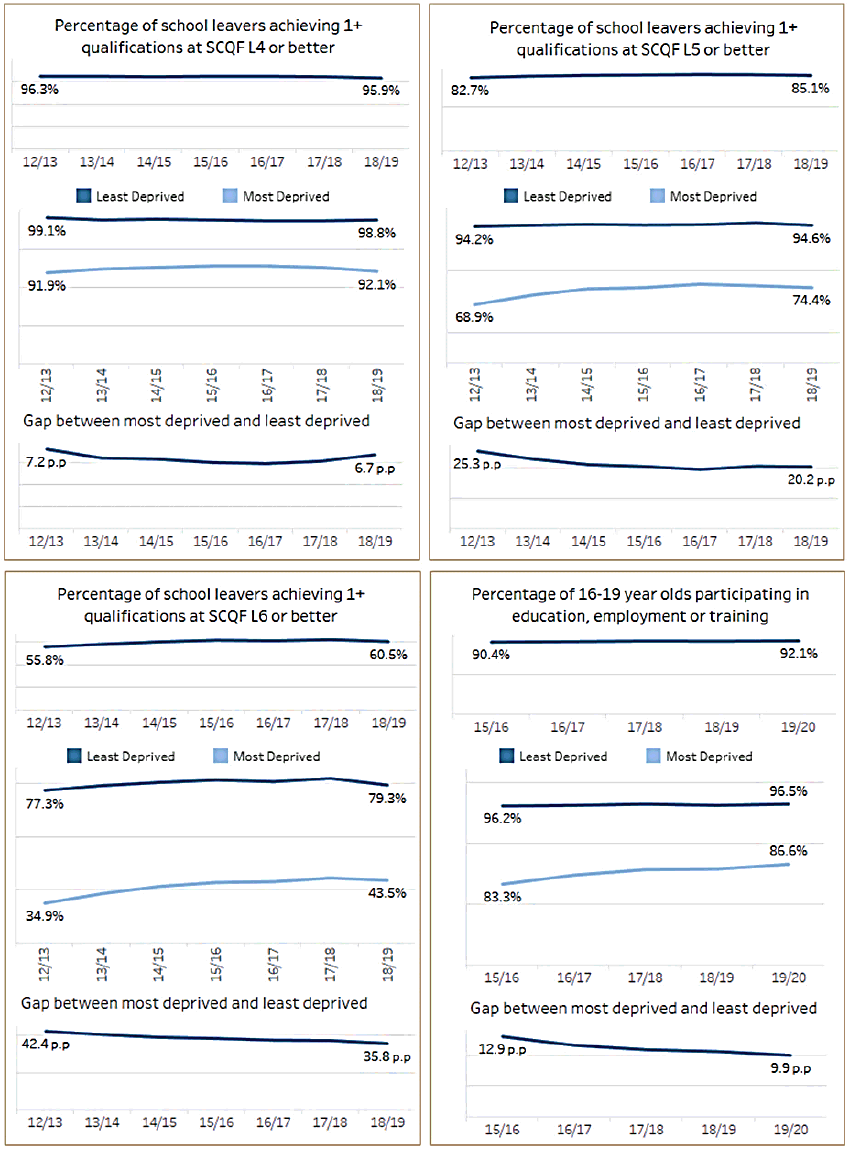Education: improvement framework and plan - 2021
Sets out the vision and priorities for Scottish education that have been agreed across the system, and the national improvement activity that needs to be undertaken to help deliver those key priorities.
Measuring the attainment gap
Closing the poverty related attainment gap remains a top priority for this Government - we want every child to have a fair chance in life, and we know that a good education is the foundation of that.
In the 2018 NIF and Improvement Plan, we set out our approach to measuring the poverty related attainment gap between children and young people from the least and most disadvantaged communities. We identified 11 key measures to assess progress, and a further 15 sub-measures that reflect the key stages of the learner journey and the breadth of issues that can impact on attainment.
As set out in more detail below, we do not have complete data for 5 of the 11 key measures. This is primarily because we could not collect comparable ACEL data this year due to the pandemic. In addition, there has been a change to the domains assessed for the 27-30 month review, which means that the stretch aim that was set for that measure is no longer appropriate.
The gap between those living in the most or least deprived areas in relation to the percentage of children having no concerns identified at their 27-30 month review has remained constant, as has that for the percentage of children and young people aged 4-12 years, and 13 and 15 year olds, in their total difficulties score.
We are also using stretch aims for each of the 11 key measures to assist the Scottish Government, local authorities and schools to develop and implement the most appropriate improvement activities to secure educational improvement for all children and young people in Scotland. The stretch aims are deliberately designed to be a challenging ambition to which those who are delivering improvement can aspire. They are not targets. At the moment, although some progress is being made, none of the measures which are showing a narrowing, are narrowing to the extent set by the stretch aims.
More detail on what the data is telling us is provided below under each measure. In aggregate, however, it serves to re-emphasise the need to intensify, deepen and accelerate progress towards closing the poverty related attainment gap, in line with the priority placed on it by the Scottish Government.
27-30 month review (children showing no concerns across all domains)
In 2016/17, there was a change to the domains assessed by health visitors at a child's 27-30 month review.
Between April 2013 and March 2017, health visitors assessed children across nine domains at their review (speech, language and communication; attention; fine motor; gross motor; social; emotional; behavioural; vision; and hearing). Since April 2017, these nine domains became eight new domains (speech, language and communication; gross motor; fine motor; personal/social; emotional/behavioural; vision; hearing; and problem solving).
This change has had an impact on the statistics produced for this key measure since 2017/18, largely due to the fact that not all Health Boards are currently assessing the new problem solving domain that was introduced in April 2017. As a result of this, the statistics produced for this key measure since 2017/18 are much lower than in pre-2017/18, because it is now not known if a child actually has no concerns across all of the current eight developmental domains (because if one or more domain is not assessed then we do not know if this is indeed the case.)
There does appear to have been an improvement between 2017/18 and 2018/19 in the percentage of children aged 27-30 months who had no concerns identified across all eight domains. However, even with the change in the number and type of domains assessed at these child health reviews, the gap between children living in the most and least deprived areas of Scotland has remained fairly constant at around 16 percentage points since 2015/16 (apart from in 2017/18 where there was a 19 percentage point gap).
HWB:Children total difficulties score (age 4-12)
The gap between children in the most deprived and least deprived areas has remained the same between 2012-15 and 2016-19, at 16 percentage points.
HWB:Children total difficulties score (age 13&15)
The gap between children in the most deprived and least deprived areas has remained the same between 2015 and 2018, at 8 percentage points.
This means that we have not seen demonstrable progress against the stretch aims for either of these measures.
Primary - Literacy (P1, P4, P7 combined)
Secondary - Literacy (S3, 3rd level or better)
Primary - Numeracy (P1, P4, P7 combined)
Secondary - Numeracy (S3, 3rd level or better)
As a result of COVID-19 and the closure of schools in March 2020, the Scottish Government decided that it would not be appropriate for the collection of Achievement of CfE level (ACEL) data for 2019/20 to go ahead. The data for these four measures, therefore, has not changed since 2018/19. However, in the period up to 2018/19, the data shows that the gap between the proportion of primary pupils from the most and least deprived areas, who achieved their expected level in literacy, has reduced since 2016/17. The gap between the proportion of primary pupils from the most and least deprived areas who achieved their expected level in numeracy reduced slightly between 2016/17 and 2017/18, and has remained stable between 2017/18 and 2018/19. The picture is slightly different at S3, where the gap between the proportion of pupils from the most and least deprived areas who achieved their expected level in literacy reduced slightly between 2016/17 and 2017/18, but then increased slightly between 2017/18 and 2018/19. There has also been a narrowing of the gap between the most and least deprived areas for pupils in S3 who achieved their expected level in numeracy since 2016/17.
SCQF Levels 4, 5 and 6 (1 or more on leaving school)
The current gap, based on school leaver attainment between 2015/16 and 2018/19 shows an increase in the gap for pupils leaving school with 1 or more qualification at SCQF Level 4 (due to a slightly lower percentage of pupils leaving school from the most deprived areas with at least one qualification at this level).
Over the same time period, there has been little change in the percentage of pupils from the most and least deprived areas leaving school with 1 or more qualification at SCQF Level 5. As such, the gap has remained virtually the same.
Finally, for pupils who left school with 1 or more qualification at SCQF Level 6, the gap has narrowed between 2015/16 and 2018/19, from 38.5 percentage points to 35.8 percentage points. This narrowing of the gap is in part due to an increase in the percentage of pupils leaving school with at least one qualification at this level from the most deprived areas over this time period, but also due to a fall in the percentage of pupils leaving school with at least one qualification at this level from the least deprived areas.
This means that, for these 3 measures combined, the gap is not closing as quickly as set out in the stretch aims.
Participation measure
The participation measure shows that the proportion of 16-19 year olds participating in education, training or employment has been improving since 2017. The gap between the proportion of 16-19 year olds in the most deprived areas participating in education, training, and employment compared with those in the least deprived areas has narrowed from 11.5 percentage points to 9.9 percentage points.
This narrowing of the gap is due to the proportion of 16-19 year olds participating in education, training or employment increasing more for those in the most deprived areas than for those in the least deprived areas. Although clear improvements have been made, the gap is not closing as quickly as set out in the stretch aim.
Summary tables of the key measures are set out below, while the 15 sub-measures can be seen in the NIF Interactive Evidence Report.

For the 27-30 month review, only data for 2018/19 is shown in the above chart.


Next steps on closing the attainment gap
A number of steps have been taken as part of the response to COVID-19 and in support of our ambition of closing the gap. While not comprehensive, these include:
- An increased support for families to engage with learning at home, including via Glow and a range of new national digital learning resources. Education Scotland has committed to strengthening its close working with e‑Sgoil, widening access for learners to live lessons, providing timetabled online classes, and training additional teachers to provide online learning as part of a wider e‑Learning National Offer.
- £80 million of additional investment in education staff, sufficient for the recruitment of around 1,400 additional teachers and 200 support staff. It is anticipated that these additional teachers will intensify support for individuals or groups of pupils who have significant gaps in their progress as a result of lockdown, supporting young people who are shielding, supporting small groups of learners who need more intense support and covering classes for teachers who are shielding.
- The provision of flexibility to redirect Attainment Scotland Funding to help mitigate the impacts of school closures on our most disadvantaged families, and to make adjustments to existing plans to be delivered as schools return.
- For the first time, Pupil Equity Fund allocations were confirmed for two years (totalling £250 million over 2020/21 and 2021/22), benefitting 97% of schools and giving headteachers assistance in their planning and decision making. As well as taking total investment in the Scottish Attainment Challenge to over £750 million over the last five years, this also extends the programme for a further year beyond this Parliamentary term and provides invaluable long‑term commitment.
- A further £10 million has been made available so councils can continue providing free school meals through the winter breaks with future funding confirmed to extend support over Easter. The policy of providing free school meals to the 168,000 pupils in primaries 1 to 3 continues to save families an average of £400 per child, per year.
- The experience of lockdown shows that access to technology and digital capability is, and will remain, a fundamental aspect of education in Scotland. Despite pupils now being physically back at school, we are still committed to tackling digital exclusion. We are investing £30 million as part of a huge digital boost through provision of laptops for disadvantaged children and young people, which includes £25 million to enable a rollout of digital devices to school pupils to enable them to study online.
In addition to these, guidance has been produced by the CERG to support teachers and other professional practitioners in preparing the curriculum offer for the recovery phase, with an emphasis on prioritising the physical, mental and emotional wellbeing of children and young people, practitioners and families. The CERG will continue to review and update key guidance for schools, including guidance on ensuring continuity in learning and on the curriculum during the recovery period.
Our experience during COVID-19 school closures also reinforced the vital role played by community learning and development in supporting young people and families - a role that will become ever more important in our recovery year. As part of our support to the sector we have provided £3 million to a new Youth Work for Education Recovery Fund, supporting young people to engage with youth work activities that build their confidence and skills, support their health and well‑being, and address the poverty‑related attainment gap.
We know that many children and young people will have had interrupted learning during the course of 2020, and that this impact is likely to be felt disproportionately by children and young people from disadvantaged backgrounds.
As we progress with accelerating and intensifying support for learning, it is essential that we do so based upon a rigorous evidence base. The forthcoming Equity Audit – developed through a rapid evidence review plus a deep dive in 54 schools, including engagement with headteachers, practitioners and support staff, parents and young people - will deepen our understanding of the impact on children from disadvantaged backgrounds, as well as improve our awareness of the key drivers behind this and local insight on:
- health and wellbeing
- educational experiences
- educational attainment
- factors which mitigate against negative impacts
Emerging themes from that Equity Audit include:
- Most stakeholders identified that both the mental and physical health and wellbeing of pupils had been negatively impacted during school building closure.
- Of particular importance to children and young people, was the loss of face-to-face teaching and the inability to socialise with friends.
- Children in the early years of primary, or those starting secondary, were most likely to have seen a negative impact on their progress.
- Literacy was more often cited as being affected negatively than numeracy.
- Children for whom English was an additional language often had to revisit skills they had developed prior to the school closure, in both their mother tongue and in English.
- Schools which were already using online platforms were better placed to move to online learning and teaching.
- Pupil motivation and engagement were strongest where there was consultation and choice about learning tasks.
- Engagement with, and feedback from, teachers was noted by many parents and pupils as an important factor in supporting continued learner engagement.
- Collaboration with partners and other agencies enabled schools to better identify vulnerable families and put in place tailored support.
- During and after school building closure, schools reported food insecurity as an emerging issue.
- In a few cases, pupils reported they had found it easier to learn in a remote setting, particularly where they already had good digital skills and parental support.
- All stakeholder groups were able to highlight measures their school, local authority or partner organisations had put in place to mitigate the impact of school building closures.
It is clear from this that an ongoing and long term focus is required to help further close the attainment gap, and to address the impact the pandemic has had on some of the most vulnerable children and families.
As committed to in the Programme for Government we will also publish further evidence of progress made to date by March 2021, including analysis of the learning from the first five years of the Scottish Attainment Challenge. This will include a detailed review by Education Scotland of the practicalities of the Attainment Challenge at local authority level.
Drawing upon this suite of evidence, the Scottish Government will work with partners, including our International Council of Education Advisors, to design the best approach to accelerating progress. A key component of this will be through the next phase of the Scottish Attainment Challenge.
The ICEA has said in its report that, even as Scotland works through the immediate changes brought about as a response to the pandemic, it should keep an eye on the future. The Report suggests that with thoughtful planning and management, the destructive effects of COVID-19 may be converted to positive developments within Scottish education in the longer term. Building on its foundational belief in equity and excellence, there is every chance that Scottish education can be a global standard bearer of education in a post-pandemic world.
Contact
There is a problem
Thanks for your feedback